A complete pre-storage guide for short-term, long-term, indoor, and outdoor care
When the riding season ends, your ATV deserves proper care before it goes into rest. Skipping preparation can lead to corrosion, dead batteries, stale fuel, or rodent damage — issues that cost time and money later.
Whether you’re parking it for weeks or months, your approach should change. Short-term storage keeps things ready to roll; long-term storage demands deeper steps to protect fuel systems and prevent rust.
Indoor and outdoor conditions also shape your plan — garages offer stability, while outdoor setups require stronger protection from weather and pests.
Before getting to the ATV storage preparations, let’s start with how long your ATV will rest and where—because storage duration and location set the stage for every step that follows.
Jump To Contents
- Decide Storage Duration & Strategy: Short-Term vs. Long-Term
- Choose the Proper Storage Location: Indoors or Outdoors
- Pre-Storage Cleaning and Drying: A Clean Start for a Safe Rest
- Inspection and Repairs Before Storage: Fix It Before You Park It
- Fuel System Preparation: Keep It Fresh and Functional
- Engine, Drivetrain, and Fluids: Protect the Heart of Your ATV
- Battery Care: Keep the Power Alive
- Tires, Suspension, and Stance: Preserve the Foundation
- Corrosion and Surface Protection: Shield Every Inch
- Rodent, Pest, and Debris Mitigation: Keep Uninvited Guests Away
- Covering and Environmental Controls: Guard Against the Elements
- Security and Safety Preparations: Protect What You’ve Preserved
- Final Pre-Storage Walkthrough: Seal the Deal
- Well-prepared Storage Prep Always Pays Off
Decide Storage Duration & Strategy: Short-Term vs. Long-Term
Getting the timeline right is key. Knowing how long your ATV will sit helps you prevent corrosion, fuel issues, and battery damage before they happen. The way you prepare your quad for a few weeks versus a few months can make all the difference when you fire it up again.
- Short-term (under 3 months): Fill the tank, add stabilizer, and run the engine to circulate it. Keep the battery connected to a tender, check tire pressure, and wipe exposed metal with light oil.
- Long-term (over 3 months): Drain carburetors, stabilize EFI systems, remove the battery, and grease terminals. Elevate the ATV to relieve tire stress and apply rust protection across exposed metal.
Always check your owner’s manual or warranty terms before making changes.
Once you’ve set your storage duration, the next step is choosing the right place to store your machine — because where it rests is just as important as how it rests.
Choose the Proper Storage Location: Indoors or Outdoors
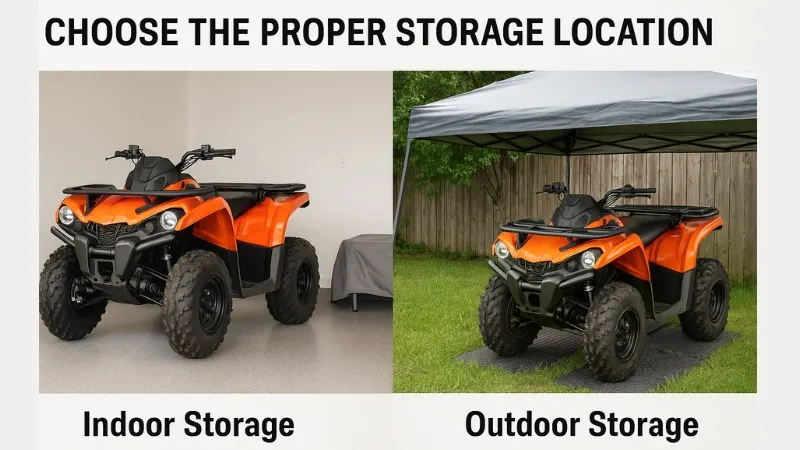
Where your ATV rests can make or break your prep work. Moisture, temperature swings, and sunlight all influence how well it survives storage, and selecting the proper location prevents most of the problems that follow months of downtime.
- Indoor storage: A climate-controlled garage or shed is ideal — dry, ventilated, and free from chemicals or fertilizers. Use moisture absorbers if needed.
- Outdoor storage: Pick a flat, well-drained surface. Avoid grass or dirt. Elevate the ATV on mats or pavers and use a weatherproof, ventilated cover. Stay clear of trees that drop sap or debris.
- Security: Choose a visible, well-lit area with anchor points for locks and nearby power if you use a battery maintainer.
With the perfect spot chosen, it’s time to get your ATV clean — because dirt and grime are the biggest enemies of long-term storage.
Pre-Storage Cleaning and Drying: A Clean Start for a Safe Rest
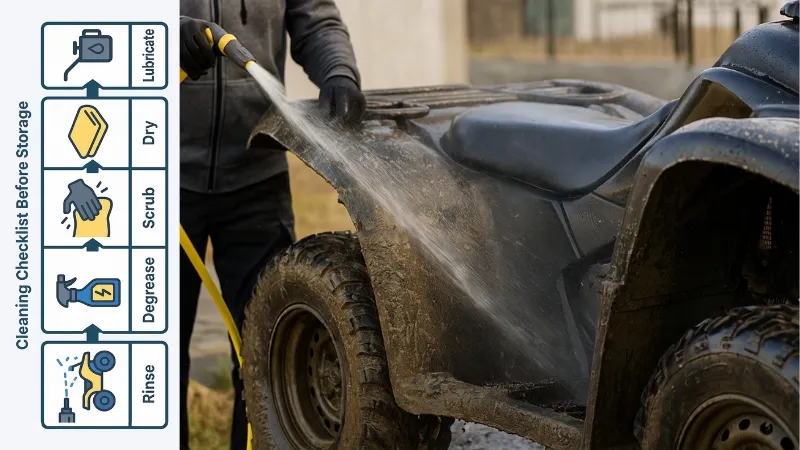
Cleaning isn’t just for looks — it’s vital protection against corrosion and hidden damage. A spotless ATV stays healthier in storage and makes every other step more effective.
- Rinse thoroughly to remove mud, salt, and grit.
- Use an ATV-safe cleaner on the frame, wheels, and undercarriage.
- Scrub joints and skid plates, where grime hides.
- Degrease and dry completely — moisture breeds rust.
- Lubricate metal parts once dry to seal out air.
Once your ATV is spotless, it’s the perfect time to check for weak points. A quick inspection now can save you hours of repair later.
Read: Is Your ATV Not Starting Properly? – 14 Reasons & Smart Fixes
Inspection and Repairs Before Storage: Fix It Before You Park It
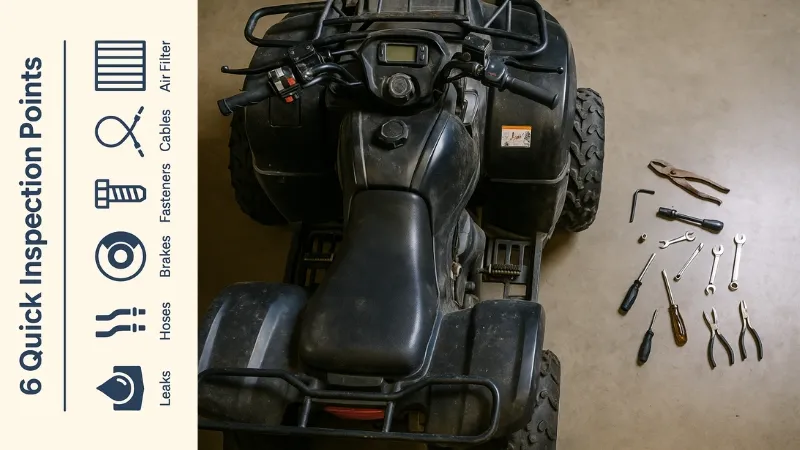
A clean ATV makes flaws easy to spot, and fixing them now prevents headaches later. A few minutes of careful inspection can prevent seized parts, leaks, or rust from sneaking up during storage.
- Check for leaks around the engine, tires, and brakes.
- Inspect hoses and boots for cracks or stiffness.
- Tighten loose bolts and fittings.
- Examine brakes for pad wear and rust.
- Test cables and levers, lubricate if sticky.
- Inspect the air filter and housing for dirt or oil.
Once you’ve ticked off the basics, it’s time to handle the next big concern — your fuel system, where improper prep can turn gas into trouble.
Read: What to Do If ATV Makes Buzzing Sound When Trying to Start
Fuel System Preparation: Keep It Fresh and Functional
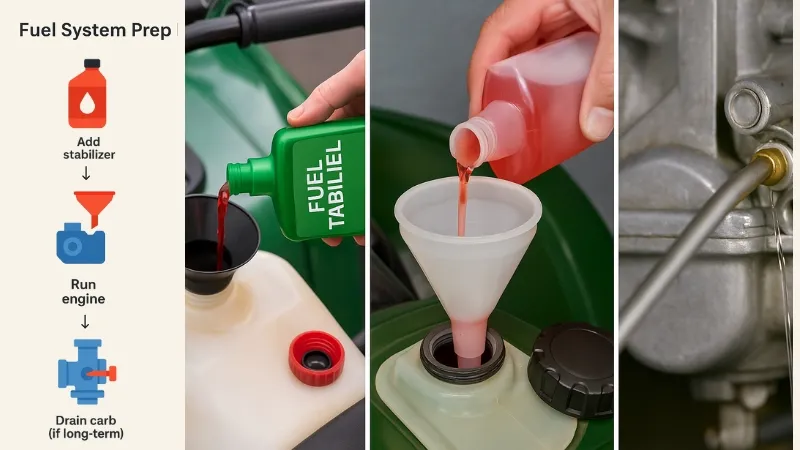
Fuel can spoil, gum up, or attract moisture during storage. Preparing it properly prevents hard starts and engine damage when you’re ready to ride again.
- Short-term: Fill the tank, add stabilizer, and run the engine 5–10 minutes.
- Long-term: Drain the carburetor or fully stabilize EFI systems.
- Inspect fuel lines for cracks and replace if brittle.
- Avoid ethanol blends — they draw in water and corrode parts.
With the fuel system safe, your next move is to protect the engine and fluids that power your ATV’s heart.
Read: Why Does ATV Backfire and How to Fix It?
Engine, Drivetrain, and Fluids: Protect the Heart of Your ATV
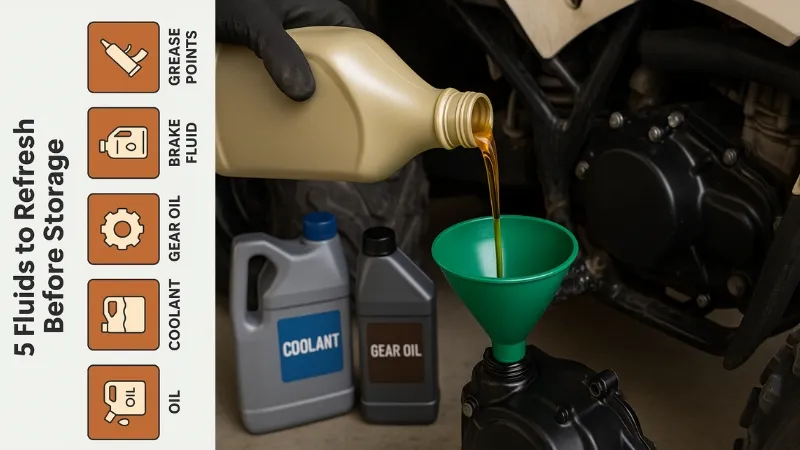
Old fluids corrode and break down when left to sit, but a quick refresh locks in long-term protection. Your goal: seal out moisture, prevent acid buildup, and keep everything lubricated.
- Change engine oil and filter.
- Top off coolant with freeze protection checked.
- Inspect and replace gearcase or differential oils if needed.
- Grease all fittings and pivots.
- Clean or replace the air filter.
- Fog cylinders for long-term storage if the manufacturer suggests it.
Once your engine and drivetrain are secure, focus shifts to preserving the battery — the power source that brings your ATV to life.
Read: Best ATV Batteries (2025): Top 11 Trail-proven Picks & Real-World Exposer
Battery Care: Keep the Power Alive

A dead battery is the easiest problem to avoid. A little maintenance now guarantees your ATV starts strong when you bring it back out.
- Short-term: Keep the battery installed on a smart maintainer.
- Long-term: Remove it, clean terminals, and apply dielectric grease.
- Store in a cool, dry place away from direct sunlight.
- Check the voltage periodically to ensure it stays within healthy limits.
With the spark preserved, turn your attention to the components that support your ride — the tires and suspension.
Read: How to Mount ATV Tires on Rims – The Ultimate Guide in 2024 & Beyond
Tires, Suspension, and Stance: Preserve the Foundation

Your ATV’s tires and suspension quietly bear the weight of storage. Protect them now to avoid flat spots or fatigue later.
- Clean and inspect tires for cracks or leaks.
- Inflate to the correct PSI.
- Elevate the ATV on stands for long-term storage.
- If on the ground, roll it occasionally to prevent flat spots.
- Use a rubber protectant on sidewalls for outdoor storage.
With your ATV resting properly, it’s time to defend it from the silent forces of corrosion and oxidation.
Corrosion and Surface Protection: Shield Every Inch

Even in storage, moisture and air attack unprotected metal surfaces. A few simple coatings can make all the difference.
- Apply corrosion inhibitor or light oil to exposed metal.
- Lubricate chains and cables.
- Treat plastics and vinyl with UV protectant.
- Condition the seat to prevent cracking.
- Plug exhaust and intake openings to block pests and debris.
Now that your ATV’s surfaces are sealed, let’s make sure no unwanted visitors try to make it their home.
Rodent, Pest, and Debris Mitigation: Keep Uninvited Guests Away
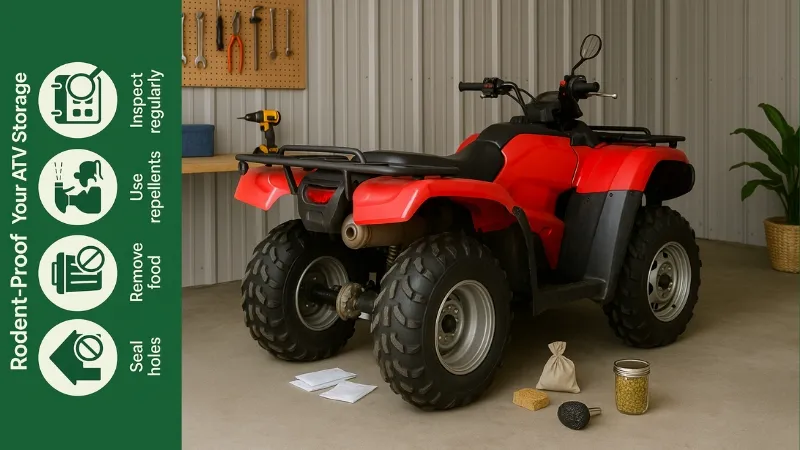
An idle ATV can become a cozy nesting spot if you’re not careful. Keep critters out with simple preventive steps.
- Remove food or wrappers that attract pests.
- Seal openings with breathable foam or mesh.
- Place deterrents like peppermint pouches or dryer sheets nearby.
- Set traps in the storage area if you’ve had rodent problems before.
- Inspect occasionally for nests, droppings, or chewed wires.
Once pests are dealt with, it’s time to protect the ATV from a different kind of intruder — the weather.
Covering and Environmental Controls: Guard Against the Elements
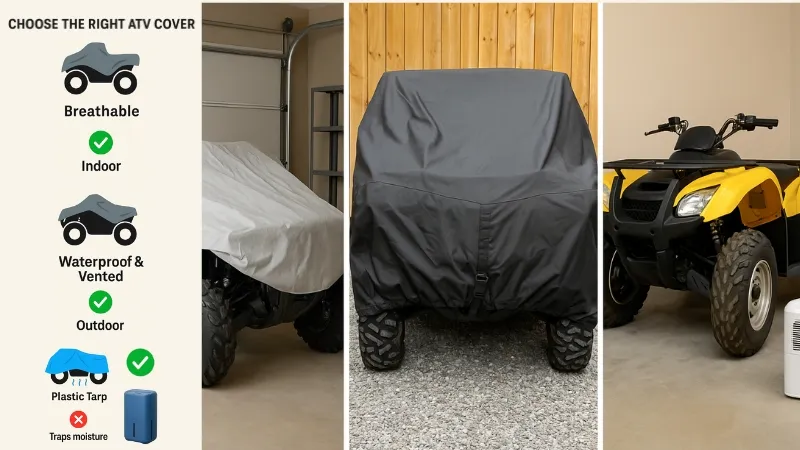
The final layer of protection is physical — a quality cover that shields your ATV from the elements. The right setup keeps dust, water, and sunlight from undoing all your work.
- Indoor storage: Use a breathable, dust-proof cover and add desiccant packs if humidity is high.
- Outdoor storage: Choose a weatherproof but ventilated cover with secure straps.
- Raise the ATV slightly to block ground moisture.
- Inspect covers regularly for rips, pooling water, or trapped condensation.
Your ATV is now protected from the environment — all that’s left is to make sure it stays safe and right where you left it.
Security and Safety Preparations: Protect What You’ve Preserved
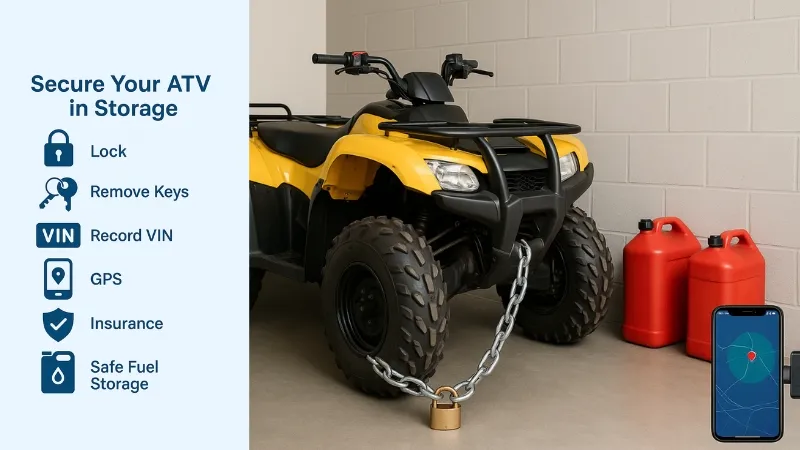
After all this effort, safeguarding your ATV against theft and hazards is the final essential step. A few extra precautions guarantee peace of mind until the next ride.
- Lock the ATV with a heavy-duty chain or disc lock.
- Remove the keys and store them separately.
- Record the VIN and take photos for insurance documentation.
- Check your insurance policy for theft and storage coverage.
- Add a GPS tracker for outdoor or remote locations.
- Store fuel and chemicals safely, away from heat sources.
- Ensure ventilation and keep cords neatly routed to avoid sparks.
Now, take one last look — because your ATV’s perfect storage setup is just one step away from being sealed and complete.
Read: Why Is My ATV Overheating? – Causes, Fixes, and Prevention Guide

Final Pre-Storage Walkthrough: Seal the Deal
Before you close the door, take a slow lap around your ATV. This final check ensures every detail is in place and every safeguard locked in.
- Fuel system: Treated or drained.
- Battery: Maintained or removed.
- Tires and suspension: Supported or inflated.
- Fluids: Changed and topped off.
- Cover: Breathable, secure, moisture-free.
- Security: Locked, tracked, and documented.
This last look transforms your prep into protection. You’ve just ensured your ATV will rest easy — and wake up ready to roar.
Well-prepared Storage Prep Always Pays Off
Every hour spent on proper storage saves days of frustration later. Your ATV will start easier, run cleaner, and stay stronger when you treat the off-season as part of its care — not just downtime.
With everything clean, protected, and secure, you can walk away knowing your ride is ready for whatever comes next — from frozen trails to summer dunes. So, when you finally roll it out again, all you’ll need to do is turn the key and smile.
Relevant reads include: